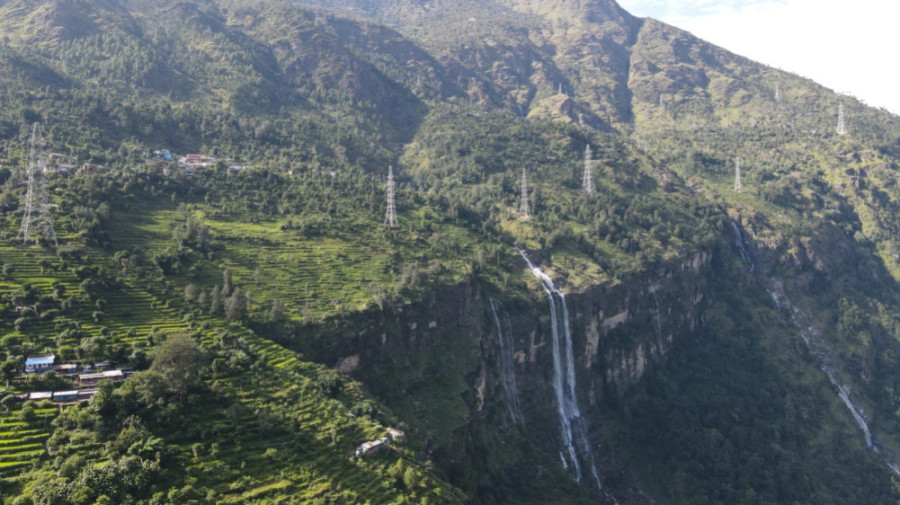Money
Nepal completes 220kV Chilime-Trishuli transmission line
This crucial development for the energy sector could open the doors to electricity trading with China.
Sangam Prasain
The 220kV Chilime-Trishuli transmission line project has been completed after seven years of construction. This crucial development in the energy sector is expected to open the doors to electricity trade with China.
The Chilime-Trishuli transmission line links two locations: Chilime, a small village close to the Chinese border in the north of Kathmandu in Rasuwa district, and Trishuli, a smaller town in Nuwakot district.
According to the Nepal Electricity Authority, this transmission line project is extremely important for Nepal because it will benefit electricity producers and facilitate power trading with the northern neighbour, China.
Kulman Ghising, managing director of the Nepal Electricity Authority, said in a statement issued on Monday, "The Chilime-Kerung international transmission line will be built for electricity trade with China, the neighbouring country to the north. The Chilime-Trishuli transmission line will serve as a link to China.”
During the then prime minister Pushpa Kamal Dahal’s visit to China in September last year, the two sides signed an agreement to develop the Nepal section of the proposed 220kV Jilong/Kerung-Rasuwagadhi-Chilime cross-border transmission line with a Chinese grant.
“The two sides will launch the construction of the Jilong/Kerung-Rasuwagadhi-Chilime 220kV cross-border power transmission line at an early date,” according to the joint statement issued during the visit.
The two sides agreed to build the first transmission line connecting the two neighbours. Currently, without grid connectivity with China, Nepal relies solely on India for importing electricity during the dry season and exports its surplus power during the wet season.
Around a dozen cross-border transmission lines are already in operation, including one with 400kV capacity to India, while four other 400kV cross-border grids extending southwards are in the pipeline.
According to the NEA officials, the Nepal section is 16 km from the China border to the Chilime hub, while the Chinese will need to construct around 80 km from its side to the border.
This project is designed to evacuate electricity generated from the Trishuli River basin, marking a significant milestone in Nepal's energy infrastructure.
This is the key power evacuation project that would benefit the projects, including the 216MW Upper Trishuli-1, 60MW Upper Trishuli 3A, and the 36MW Upper Trishuli 3B hydroelectric projects.
The transmission line would also evacuate power from the 14.6MW Upper Sanjen, 42.5MW Sanjen, 111MW Rasuwagadhi, 14.3MW Upper Mailung, and 5MW Upper Mailung A hydroelectric projects.
The 28 km Chilime-Trishuli 220 kV double circuit electricity transmission line has 76 pylons.
“The facility would evacuate power from the 111MW Rasuwagadhi Hydropower Project and 42.5MW Sanjen Hydropower Project, both built under the authority's subsidiary company, Chilime Jalvidyut,” said Ghising, adding that the Rasuwagadhi and Sanjen projects have been completed and are in the power generation stage.
“This transmission line will also help many other hydropower projects under construction in the area.”
"Erecting a pylon was challenging in many areas. The mountainous terrain meant many places did not have roads, so people or mules had to carry conduction materials like stones, sand, water and pylon parts. Additionally, floods and landslides, forest clearance, local obstacles and Covid-19 also created hurdles,” said Ghising.
According to the NEA, 33 pylons had to be constructed in places without access roads.
“Despite all odds, we have completed the project through our continuous efforts,” said Ghising.
Tharka Bahadur Thapa, chief of the grid operation department of the NEA, said the project built more than 20 kilometres of access roads.
He said that nine pylons were constructed by transporting construction materials and equipment by mules and people, while two were built by transporting construction materials by helicopter. In most mountain areas, drones were used to connect the overhead line cables from one pylon to another.
The 65 million euro (approximately Rs9.49 billion as per Monday’s exchange rate) project was jointly financed by the German government through its Development Bank KfW (grant of 14 million euro), European Investment Bank (loan of 25 million euro), the European Union under its Asia Investment Facility (2.25 million euro) and the rest by Nepal government.
In October 2017, Chinese firm Pinggao Group of Companies was awarded the contract to build the transmission line and substation. The transmission line project includes the construction of the 220/132 kV Trishuli 3B hub substation, the 220/132 kV Chilime substation, and the Chilime-Trishuli 220 kV double-circuit transmission line.
The transmission line has been constructed at elevations ranging from 680 to 2,600 metres above sea level.




 8.12°C Kathmandu
8.12°C Kathmandu













%20(1).jpg&w=300&height=200)
